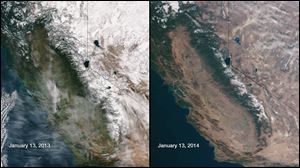
Feds announce another $14M for California drought
2/5/2014
This image provided by NOAA compares January 13, 2013 and January 13, 2014 snow cover in Northern California and Nevada as seen by the Suomi NPP satellite. California, which is seeing its driest conditions in 500 years, is experiencing extreme drought in more than 62 percent of the state.
SACRAMENTO — Federal officials today pledged more money to help California cope with its severe drought as state fishing regulators shut down recreational angling on portions of two water-starved rivers because of concerns about the survival of salmon and steelhead trout.
The U.S. Bureau of Reclamation and Natural Resources Conservation Service announced another $14 million for water management improvements in the state, a day after Agriculture Secretary Tom Vilsack committed $20 million.
Meanwhile, California’s Fish and Game Commission continued banning fishing on drought-stricken state waterways.
The panel voted unanimously to abolish fishing on parts of the American and Russian rivers after the California Department of Fish and Wildlife closed dozens of others last month.
California has already taken steps to address concerns over the drought, including cutting deliveries from the State Water Project to farms and cities, and urging statewide conservation.
State wildlife officials said the drought-related fishing closures are the most extensive the state has ever implemented.
Chuck Bonham, director of fish and wildlife, said the decision is meant to save as many fish as possible, so that when the drought eases there will still be some left to catch.
Bonham said the conditions could worsen to the point that crews will have to go into rivers and streams to rescue endangered fish.
“We may need to put hands on legally protected fish, and bring them in to protect their DNA from extinction,” Bonham told the commission.
The commissioners found that dangerously low stream flows and dwindling reservoir storage presented a danger to salmon and steelhead habitat in both watersheds.
The closures on both rivers will extend through April 30.
Numerous fishing groups voiced support for the closures.
Lowell Ashbaugh, a fly fisherman from Davis, said he hated having to close a river to fishing, but that it was for the greater good.
“The conservation of the river is very important,” he told the commission. “If we don’t have the fish, we don’t have the fishing.”